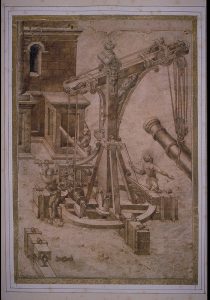
This post was written by Noa Turel, Ph.D./Assistant Professor, Department of Art & Art History, University of Alabama at Birmingham and Dibner Library Fellow, January-March 2016. Applications are currently open for 2017 fellowship opportunities.
My three-month winter residency at the Dibner Library of the History of Science and Technology was tremendously helpful in shaping and grounding my book project Ingenious Secrets: Painting and Research in Fifteenth-Century Courts. Coming in, I had three bibliographies of Dibner Library special collections materials through which I sought to advance my understanding of the phenomenon at the heart of this book, the curious employment of painters as engineers in Renaissance courts. The rare books, manuscripts, and visual materials I found in the course of my residency far exceeded my original estimation in the proposal. I wound up consulting many more items as well as secondary sources, finding over 130 to be helpful for my research.

The most significant research accomplishment facilitated by the excellent collections at the Dibner Library was the mapping of the history of illustrated treatises on machines, military and other, in Western Europe. Working my way backwards from one of the unique treasures of the library, a group of drawings associated with Agostino Ramelli’s Le Diverse et Artificiose Machine (Paris, 1588), possibly by the author’s own hand, I was able to identify the key treatises that preceded that famous work in Renaissance Europe and trace the fascinating genealogy of their image programs to several late-medieval and four key ancient sources. The late Mr. Dibner’s tendency to collect different editions of the same text proved essential to this research. For instance, by consulting the many editions of De re militari by the fourth-century Roman statesman Vegetius found at the library, I was able to piece together a fascinating picture of the dissemination of mechanical knowledge in Western Europe. This popular text, within the reference genre second in extant medieval manuscripts only to Pliny’s Natural History, first emerged in illustrated printed versions in the vernacular, despite the fact that the early incunabula of the treatise are all in Latin. Furthermore, those illustrations draw on visual sources such as (copies of) the Bellifortis, a 1405 magic and military engineering treatise by the retired court physician and counselor Conrad Kyeser, suggesting the degree to which courts, operating in the vernacular and heavily reliant on visual modes of communication, emerged in the fifteenth century as powerful alternatives to the traditional centers of knowledge production and transmission such as universities and monasteries.

The narrative that emerged from my findings at the Dibner Library confirmed some of my original hypotheses and dispelled others. For instance, I discovered that the earliest authors of engineering treatises in Western Europe were physicians, rather than painters, which, coupled by the progressive specialization of military arts professionals from about the turn on the sixteenth century, suggests that the phenomenon of painter-engineers is mostly confined to the specific conditions and prevalent discourse of fifteenth-century courts. Better understanding the scope of the phenomenon led me to refine my central working hypothesis for the book and better target the archival research in which I am currently engaged.
The fellowship tenure at the Dibner Library was not only productive but also tremendously pleasant. Lilla Vekerdy and Kirsten van der Veen are some of the most knowledgeable, proactive, helpful, and collegial library professionals I have ever had the pleasure of working with. Their advice and efforts to facilitate research were greatly conducive to my project. The culture of openness and commitment to making rare objects as available as possible both to researchers and the public is wonderful and, among the many libraries I have previously used throughout the U.S. and Europe, the Dibner truly stands out as exemplary.

One Comment
good picture in your post, i like.